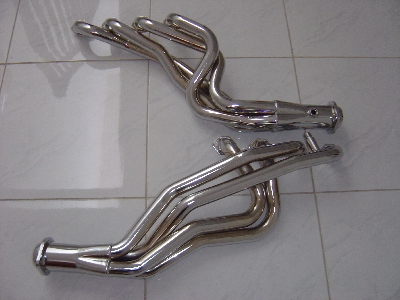Exhaust Upgrades
Home | Free Mods | Intake | Ported Heads & Manifold | Exhaust | Gears | Transmission | Brakes | Parasitic HP | Fuelling | Interior | Weight | Performance | HP Gains | PartsThe stock exhaust system on a 1995 Mustang GT is a true dual system that can be divided into three sections:
Front: Cast iron exhaust manifolds.
Middle: 2-1/4" H-pipe with four catalytic converters and crossover.
Rear: Two mufflers with 2-1/4" tailpipes.
The main points of restriction are the manifolds, catalytic converters, and the mufflers. The stock 2-1/4" pipes present minimal restriction on an engine producing less than 400hp.
Upgrades to the exhaust system are usually close to the top of a Mustang owner's modding list because these produce decent horsepower/torque gains at relatively low cost.
The most popular first upgrade of the exhaust system is to either have new performance mufflers welded into the existing pipework, or replace the stock mufflers and tailpipes with new performance cat-backs. Performance mufflers alone can yield a 5hp gain at the wheels and if the stock tailpipes are in good condition, they can be dressed up with sexy-looking chrome tips.
The stock exhaust manifolds are highly restrictive so replacing them with headers is a popular upgrade. Headers can be divided into three types; long tube, mid-length, or shorty. Shorty headers are a straight replacement for the stock manifolds and allow you to reuse the existing mid-section. Mid-length and long tube headers are more difficult to install and require a custom crossover H-pipe or X-pipe to complete the installation, but they yield more HP/TQ than shorty headers, look sexier, and sound much cooler.
The final piece in the jigsaw is the mid-section. This can be either an H-pipe or an X-pipe, and these either have two catalytic converters (for the smog conscious) or straight pipes (the offroad versions).
My first upgrades were to replace the stock mufflers with two free-flowing 2-1/2" straight-through units, and I also replaced the rear two catalytic converters in the H-pipe with two more 2-1/2" straight-through mufflers and 2-1/2" piping on either side. These were welded into the existing pipework.
The front catalytic converters were plugged so I had those hollowed out to improve airflow.
These modifications made the middle and rear sections of the exhaust free-flowing while maintaining a sound that was almost unchanged from the original stock system. The stage was now set for the stock exhaust manifolds to be replaced with headers.
 MAC Long Tube Headers
MAC Long Tube Headers
These free-flowing HTS-coated MAC 1-5/8" long tube headers (part no. MAC-TF94015) replaced the restrictive stock exhaust manifolds. The stock manifolds don't look so bad until you see that the primary pipes are pinched down to a width of just 5/8" near the flange (height is 1-1/8").
The stock H-pipe was reused but it was shortened by 21" at the front and the hollowed out cats were removed so that it would bolt up to the 2.5" collector flanges of the MAC headers. Installation of the headers was fairly straightforward but not without a couple of clearance issues. One of the passenger side header pipes was touching the starter so that needed to be clearanced, and the same also needed to be done on the driver's side to clear the bellhousing. BBK-1676 oxygen sensor harness extension wires and MAC-3834 header bolts completed the job.
I also elected to install a set of Taylor spark plug wire boots and a heatshield on the starter to protect them from the heat radiated by the headers.